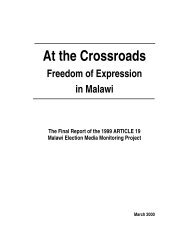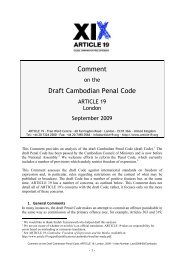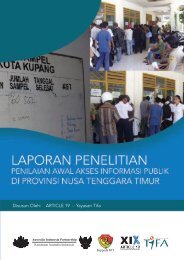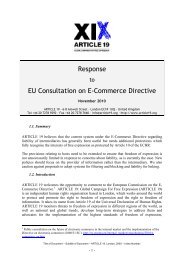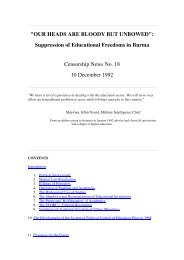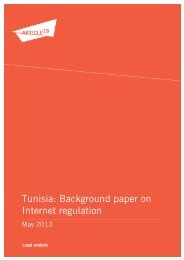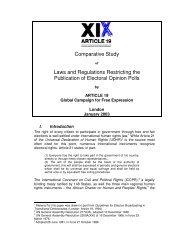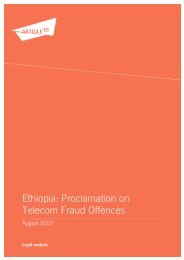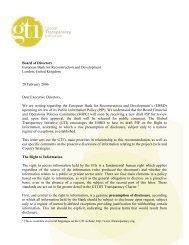FOR INTERNAL USE ONLY - Article 19
FOR INTERNAL USE ONLY - Article 19
FOR INTERNAL USE ONLY - Article 19
- No tags were found...
You also want an ePaper? Increase the reach of your titles
YUMPU automatically turns print PDFs into web optimized ePapers that Google loves.
ARTICLE <strong>19</strong>GLOBAL CAMPAIGN <strong>FOR</strong> FREE EXPRESSIONthe event of a fire. They had simply heard in the media that the phosphorus would ultimately betransported to Kazakhstan.Even more worryingly, in mid-2007 very high levels of radiation were recorded in theDonetsk oblast. It was feared this might be the cause of a series of illnesses in the area. The causes ofthe radiation remain unclear since there are no nuclear facilities there. Environmentalists have linkedthe radiation to waste present in the oblast, whose source is also unknown. 344A family from the Skvyra district (Kyiv oblast) stated that their village was declared safe bythe authorities in <strong>19</strong>86, following the Chornobyl accident. Yet, in <strong>19</strong>90 it emerged that the village wasin a contaminated area that had to be evacuated. Local people found out about the health hazards in theregion from contacts and the newspapers; the authorities made no official statements. When they stillbelieved that they were living in an uncontaminated area, the family had brought their granddaughterfrom the city of Kyiv to live with them, thinking that this would be healthier for her. In the followingyears, family members developed illnesses, including several severe allergies. They had to movehastily and found themselves in a house with extremely poor living conditions and no heating. Thiswas because, a few years after the disaster, the relocation programmes had started to shrink, makingfinding alternative housing increasingly problematic. Had they received timely notice, they may havenot developed illnesses and would have had the opportunity to arrange for better housing.Other interviewees reported that, in the late <strong>19</strong>80s and early <strong>19</strong>90s, in some villages in theShostkinskii district (at the edge of Sumy and Kyiv oblasts), several people started complaining ofpulmonary disease. All wild birds disappeared from the area and crops died. The locals linked theseevents to the high levels of emissions from chemical factories in the area. The authorities did notexplain these developments, instead simply assuring the public that there was no danger.As mentioned above, at times it is less the concerns over their health and safety that motivatepeople to want to know more, but worries over losing livelihoods or property, as well as concerns overequal opportunities and fair competition. Frequently, people learn of construction projects only whenthey are already under way. Even then, it can sometimes be difficult to obtain information. Forexample, a resident of Donetsk submitted an information request on a building development that hadstarted near her house. Three months later she informed interviewers that she had still not received areply. Another woman discovered one morning that a construction project had started on land near herhouse which led to the felling of several trees. She addressed several public bodies for information butcould not get satisfactory answers as to what was being built or by whom. In both cases, the residentswere alarmed that tree felling and the construction projects would reduce the value of their house. 345 In344 Interview with Oleg Listopad, see note 82.345 Interview with Oleg Listopad, see note 82.For Internal Use Only. Is Post-Chornobyl Ukraine Ready for Access to Environmental Information?ARTICLE <strong>19</strong>, London, 2007*



